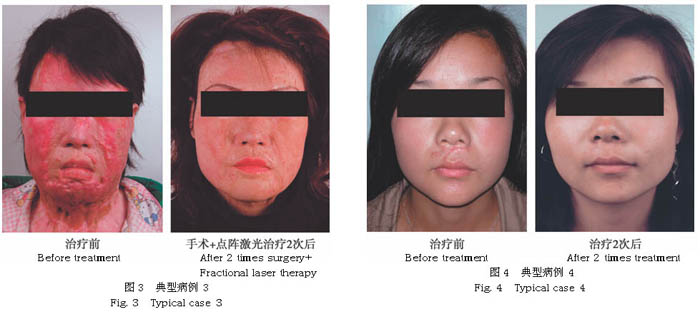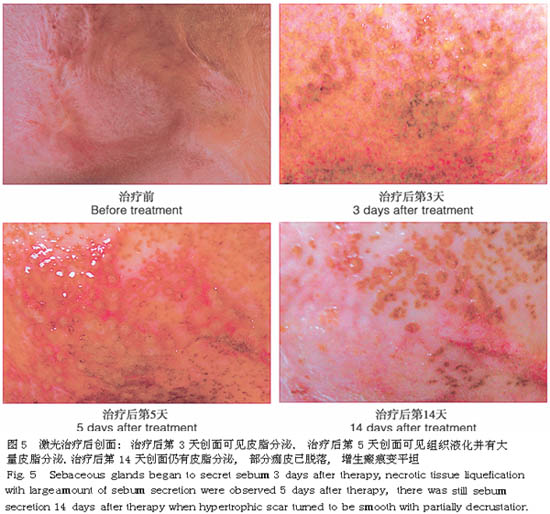- 点阵 CO2 激光结合湿性医疗技术治疗增生性瘢痕的临床效果观察

-
目录
- 2007年我国部队医院小儿烧伤住院患者信息分析
- 留学生烧伤湿性医疗技术见习带教体会
- MEBO结合中药粉剂治疗烧伤创面临床观察与问题分析
- MEBT/MEBO治疗成批氢气球爆炸致头面部深度烧伤的临床分析
- 皮肤原位再生医疗技术结合早期磨削术在面部深Ⅱ度烧伤治疗中的应用
- 皮肤原位再生复原技术治疗电弧光烧伤创面的临床体会
- 湿润烧伤膏治疗婴幼儿烧伤 60 例体会
- 严重烧伤休克期不同时间段体液代谢失调的临床研究
- 湿性医疗技术治疗烧伤感染创面
- 烧伤并发肠系膜上动脉综合征临床报告
- 干细胞在创伤愈合中的作用
- 多部位撕脱伤的整形修复与探讨
- 湿润烧伤膏用于产科侧切及会阴裂伤缝合伤口的
- 湿润烧伤膏治疗儿童足绞伤临床报告
- 中医外治糖尿病足溃疡的研究进展
- 美宝创疡贴对体表慢性溃疡治疗的体会
- 美宝创疡贴治疗慢性溃疡的临床观察
- 美宝创疡贴治疗1例痛风并发难治性溃疡的临床体会
- 美宝创疡贴治疗下肢慢性溃疡28例临床体会
- MEBO联合超声清创机治疗糖尿病足
- 点阵 CO2 激光结合湿性医疗技术治疗增生性瘢痕的临床效果观察
- 利用腓动脉穿支蒂皮瓣修复足部大面积软组织缺损
- 胃镜下清创术后口服美宝胃肠胶囊治疗难治性胃溃疡的疗效
- 湿润烧伤膏在肛肠科的临床应用
- 美宝湿润烧伤膏联合艾洛松乳膏治疗婴儿湿疹的疗效观察
- MEBO治疗药物过敏致全身剥脱性皮炎疗效观察
- 关于神经生物学的新观点(一):静息电位和动作电位是氢离子的膜电位
谭军 欧阳华伟 李高峰 李波
TAN Jun, OUYANG Hua-wei, LI Gao-feng, LI Bo
作者单位: 410005 湖南 长沙, 湖南省人民医院整形激光美容科
Affiliations: Department of Plastic and Cosmetic Laser Surgery, the People’s Hospital of Hunan Province, Changsha 410005, Hunan Prov- ince, China
【摘要】 目的 观察点阵 CO2 激光结合湿性医疗技术治疗增生性瘢痕的临床疗效并总结临床经验。 方法点阵CO2激光结合湿性医疗技术治疗不同原因所致的增生性瘢痕, 根据评定标准对治疗结果进行评价。 结果点阵CO2激光结合湿性医疗技术治疗增生性瘢痕的显效率为 84. 69% , 总有效率为 100. 00% 。结论点阵 CO2激光结合湿性医疗技术治疗增生性瘢痕疗效确切, 该技术值得临床推广。
【关键词】点阵 CO2 激光; 增生性瘢痕; 湿性医疗技术
【标识符】doi: 10. 3969 / j. issn. 1001-0726. 2011. 05. 021
【文章类型】临床研究
【Abstract】Objective Observe the clinical efficacy of fractional CO2 laser combined with MEBT / MEBO in the treatment of hypertrophic scars and summarize clinical experience. Methods The hypertrophic scars caused by different reasons are treated with fractional CO2 laser combined with MEBT / MEBO, and then evaluate the therapeutic effects based on standard. Results The significant effective rate of treating hypertrophic scars with fractional CO2 laser combined with MEBT / MEBO is 84. 69% , and the total effective rate is 100. 00% . Conclusion Fractional CO2 laser combined with Moist Exposed Burn Therapy has definite effect on hypertrophic scars. It is worthy to be popularized in clinic.
【Key words】 Fractional CO2 laser; Hypertrophic scar; MEBT / MEBO凡损伤累及真皮深层,如深Ⅱ度以上烧伤、切割伤等,均可能形成增生性瘢痕,其临床表现为瘢痕明显高于周围正常皮肤,局部增厚变硬,传统的治疗方法包括加压包扎、硅酮膜外敷、手术切除等[1]。随着激光技术的发展,激光在非手术治疗瘢痕中的作用越来越受到重视[2~3]。我科自2007年9月~2010年9月采用点阵CO2激光结合湿性医疗技术治疗增生性瘢痕98例,取得了理想的临床效果,现报道如下。
1.资料和方法
1.1.一般资料
98例增生性瘢痕患者均来自我科门诊,其中男40例,女58例,年龄为10岁~51岁,病程6个月~20年。烧烫伤瘢痕60例,切割伤瘢痕20例,挫伤瘢痕18例。瘢痕面积最小者约1cm×2cm,面积最大者约15cm×20cm。
1.2.仪器
美国科医人UltraPulseEncoreTM点阵CO2激光,配有电脑图形发生器(CPG)手具,可发射出正六边形、正方形、长方形、菱形、条形、三角形和空心圈等7种图形,图形大小1~9等,密度1~9级。当CPG关闭时,则为超脉冲模式(Ultrapulse,UP)。
1.3.治疗前准备
清洁治疗区域,照相建档,签署激光治疗同意书。治疗前2h时抹涂复方利多卡因凝胶,保鲜膜覆盖;治疗前30min口服止痛药曲马多;治疗时擦去复方利多卡因凝胶。
1.4.参数设定
ActiveFX:能量150mJ~200mJ,频率40Hz~60Hz,CPG光斑图形3,大小3mm~5mm;UP模式:150mJ,40Hz~60Hz。
1.5.治疗方法
对于大面积、凹凸不平、色泽不均的瘢痕,先用ActiveFX治疗瘢痕表面,然后用SP模式对凸起部分或凹陷区周缘部分进行间断气化治疗,使凹凸不平区形成平滑过渡。亦可先进行间断气化增生部位,再采用Ac-tiveFX行瘢痕表面治疗。
1.6.治疗后处理
立即外涂美宝湿润烧伤膏,每4h换药1次,涂药至创面完全脱痂愈合,一般2w~3w。口服迈之灵,减少组织血管渗出性水肿。同时口服积雪苷片,促进创面愈合,减少胶原合成和促进胶原降解。治疗部位严格防晒。治疗间隔3个月,第2次治疗后3个月复诊拍照并进行疗效评定。
1.7.疗效评定标准[4]
显效:80%以上瘢痕平整,视觉上无凹凸不平感,颜色接近周边正常皮肤。有效:50%以上瘢痕平整,瘢痕凹凸不平、色泽不均表现明显减轻。无效:瘢痕凹凸不平、色泽不均表现无明显改变,或出现新生瘢痕、明显色素沉着、色素减退。由未参与治疗的主治医师根据患者治疗前后的照片进行评价。
2.结果
点阵CO2激光治疗98例增生性瘢痕患者,显效83例,有效15例,无效0例,显效率为84.69%,总有效率为100.00%,治疗结果见表1。典型病例见图1~4。


3.讨论
点阵技术是根据局灶性光热作用原理,由特定的激光产生很多显微治疗孔,而微孔周围的组织则保持完好[5],其有利于创伤迅速修复[6]。点阵激光常用的光源有3种:Er:Glass(1540nm)、Erbium激光(2940nm)、CO2激光(10600nm)。科医人医疗激光设备公司的点阵激光设备Ultra Pulse Encore TM利用超脉冲CO2激光精确的组织气化特点,采用电脑飞点技术,减少了热叠加,避免组织过度损伤,较其他点阵激光具有更深的组织穿透力,被激光专业界公认为治疗皮肤病损的金标准。点阵CO2激光治疗瘢痕的机制包括:①直接气化瘢痕组织;②对病损瘢痕组织有限的热损伤,启动组织再生修复程序;③激光的高热溶解作用可使胶原的二硫键断裂,促进胶原结构重建,瘢痕变软,体积变小等;④损伤瘢痕内血管,抑制血管内皮细胞增生;⑤诱导成纤维细胞进入凋亡途径。我科采用UP模式可以治疗任何厚度的增生性瘢痕,但在治疗过程中为避免过度热损伤,应采用间断气化治疗。
临床上,很多医生只重视激光治疗过程中的参数设定,而忽视激光治疗后创面的处理,因此激光治疗后红斑反应、色素沉着、色素脱失和瘢痕加重等并发症的出现几率较高。国外研究表明[8]:CO2激光一次扫描可产生类似Ⅱ度烧伤的创面,即浅Ⅱ度创面和深Ⅱ度创面。创面愈合研究表明[9]:浅Ⅱ度创面修复是表皮层的修复,不涉及新的基质形成和伤口重建,修复的过程为表皮角质细胞增殖、迁移和分化。深Ⅱ度创面的修复过程除残存的皮肤附件的上皮细胞迁移、增殖和分化外,还有血管内皮细胞和成纤维细胞增殖及新的基质沉着和重建。创伤后,组织中的潜能再生细胞启动产生干细胞,促使干细胞有序分裂增殖的能力是有限的,必须有一种物质激活并持续提供生理的、利于分裂增殖的营养环境。由于湿性模拟生理状态的环境可以促进创面的生理愈合,使用美宝湿润烧伤膏处理激光治疗后创面,临床观察发现创面在3d~14d左右皮脂腺开始分泌(见图5),而且皮脂越多则修复的效果越好,但临床上未观察到毛囊和汗腺的修复情况。
点阵CO2激光峰值能量大,热副损伤带小,因此气化组织精确,对周围组织损伤轻,对靶组织造成有限的损伤,启动组织的再生修复程序,在激光创面修复过程中利用湿性医疗技术对创面提供湿性的模拟生理愈合环境,可以保护成体原位干细胞和残存的皮肤附属器官特别是皮脂腺的启动和增殖,促进创面的生理性愈合,避免色素沉着或色素脱失,红斑反应等气化激光治疗并发症的发生[10~11]。

激光对人体组织有限的热损伤可以启动再生修复程序,正确的创面用药可以保障再生潜能细胞启动产生干细胞,进行有序的细胞分裂、增殖、分化和改建,再生修复创面能够原位生长出具备正常结构和功能的真皮和表皮,是一种生理性愈合。虽然我科采用点阵CO2激光结合湿性医疗技术治疗增生性瘢痕取得了理想的临床效果,但与之相关的基础研究仍有待突破,一是寻找干细胞参与瘢痕修复的证据;二是比较模拟湿性生理环境与传统创面治疗技术对瘢痕激光创面的愈合影响;三是诸如缺氧和血管成分对瘢痕激光创面修复的影响等。
综上所述,点阵CO2激光结合湿性医疗技术治疗增生性瘢痕疗效确切,该技术值得临床推广,但基础研究仍有待深入。
Any injury involving deep layer of dermis, like deep Ⅱ degree burn and incised injury, can result in hypertrophic scars with the clinical manifestations of obviously elevated and localized scar in thickness and hardness. Conventional therapy includes pressure bandage, external application of silicone membrane, surgical excision, etc[1] . The therapeutic effects of laser have been attached great importance to the non-operative treatment of scars, with the development of this technique[2 ~3] . From September 2007 to September 2010, our department adopted fractional CO2 combined with MEBT / MEBO in the treatment of 98 cases of hypertrophic scars and got sufficient therapeutic results, reporting as follow.
1. Materials and Methods
1. 1. Clinical data
A total of 98 patients were admitted as out-patients with hypertrophic scars including 40 males and 58 females, at the age of 10-51, course of disease ranging from 6 months to 20 years. Among those, there were 60 cases of burn and scald induced scars, 20 cases of incised injury induced scars, 18 cases of contusion induced scars. Size of scar ranged from the minimum 1 cm×2 cm to the maximum 15 cm×20 cm.
1. 2. Instrument
LUMENIS Ultra Pulse EncoreTM fractional CO2 Laser equipped with CPG can emit 7 patterns including regularhexagon, square, rectangle, diamond, bar, triangle and hollow ring, with the size level of 1-9, density grade of 1-9. It switches to Ultrapulse (UP) mode when CPG turns off.
1. 3. Preparation before treatment
Clean the treatment area, establish photo files and sign the informed consent for laser therapy. Apply lidocaine gel 2 h before treatment and cover with plastic wrap. Give analgesic tramadol orally 30 min before treatment. Remove the lidocaine gel during the treatment.
1. 4. Parameter setup
Active FX: energy 150 mJ ~ 200 mJ, frequency 40 Hz-60 Hz, CPG facula pattern 3, size 3 mm-5 mm; UP mode: 150 mJ, 40
Hz ~60 Hz.
1. 5. Treatment method
For the large scar with uneven surface and color, Active FX was adopted on the scar surface and then intermittent vaporization treatment with SP mode on the elevated part or edge of depressed area in order to smooth the uneven surface. Intermittent evaporation treatment could also be adoptedfirst on hypertrophic area and then Active FX used.
1. 6. Post-treatment management
Immediately apply MEBO, change dressing every 4h until wound decrustation and healing, generally in 2 to 3 weeks. Give Aescuven forte orally so as to reduce leachable edema of tissue vascular. Meanwhile, administer Jixuegan tablet to improve wound healing, reduce collagen synthesis and accelerate collagen degradation. Treatment area must be protected from direct sunlight. Treatment interval was 3 months. Pictures were obtained and clinical efficacy was determined at 3 month follow up after the second time treatment.
1. 7. Assesment standard of clinical efficacy[4]
Significant effective: Over 80% of a scar is smooth without visible uneven surface and the color is close to normal skin. Effective: Over 50% of a scar is smooth, manifestations of uneven surface and ununiform color are obviously reduced. Ineffective: Uneven surface and ununiform color of a scar have no obvious change, or there is new scar, distinct pigmentation, or pigment decline. Clinical efficacy is determined based on the pictures before and after treatment by the doctors who do not involve in the treatment.
2. Result
Out of 98 patients with hypertrophic scars receiving fractional CO2 laser therapy, there were 83 significant effective cases, 15 effective cases, 0 ineffective case, significant effective rate was 84. 69% , and total effective rate was 100. 00% , see table 1. See Fig. 1 ~4 for typical cases.3. Discussion
Mechanism of fractional therapy is based on the principle of fractional photothermolysis, to form many micro holes by specific laser,while the surrounding tissue of micro holes are well preserved[5], which is favorable for rapid repair of tissue[6].There are 3 patterns of laser light in fractional laser therapy: Er: Glass (1540 nm ), Erbium laser ( 2940 nm ), CO2 laser ( 10600 nm) [7] . Ultra Pulse EncoreTM by lUMENIS Co. , with the character of accurate tissue evaporation by ultra pulse CO2 laser and computer techniques, reduces the heat overlap and avoids tissue over injuries; with its strong ability of tissue penetration compared with other fractional lasers, it has been widely accepted as the golden standard of skin disease treatment. Mechanism of fractional CO2 laser in the treatment of scars include: ① Directly evaporate scar tissue; ② Limited heat injury on the affected scar tissue activates the process of tissue regeneration and repair;③ High thermolysis by the laser breaks the disulfide bond of collagen so as to improve the rebuild of collagen structure, softening of scar, and decrease of the scar volume; ④ Damage the vessel inside scars, inhibit the hyperplasiav of vascular endothelial cell; ⑤ Induce fibroblasts into apoptosis pathway. Our department can treat hypertrophic scars with any thickness by UP mode. In order to avoid overheat injury during the treatment, intermittent evaporation therapy should be adopted.
In clinical practice, many doctors pay too much attention to the parameters setup during the laser therapy while ignore wound management after therapy, which results in higher risk of complications like rashes, pigmentation, pigment loss and scar exacerbation.Foreign research reveals[8] : Only one scan by CO laser can create a wound similar to II degree burn wound ( i. e. superficial II degree and deep II degree). Research of wound healing reveals[9] : Superficial II degree wound repair is actually the repair of epidermal layer not including new matrix formation and wound reconstruction, and the process of repair is epidermal keratinocyte proliferation, migration and differentiation. The repair process of deep II degree wound includes not only epidermal cell migration, proliferation and differentiation of residual survived appendages but also vascular endothelial cell and fibroblast proliferation and new matrix formation and wound reconstruction. Potential regenerative cells in the tissue are activated to transform into stem cells after injury. But the body’ s capacity of promoting stem cells to proliferate is limited, and there must be a substance to activate and continuously provide a physiological and nutritional environment favorable for division and proliferation. Since the moist environment can improve wound healing physiologically, the wound treated with MEBO after laser therapy was observed having sebaceous gland to secret sebum on 3 -14 d, (see Fig. 5); moreover, more sebum secretion indicates better repair, but we do not observed the follicle and sweat gland repair.
Fractional CO2 laser therapy with large peak energy and small thermal radiation zone can evaporate tissue precisely with slight damage to the surrounding tissue and specific damage to the target tissue. It activates the process of tissue regeneration and repair, MEBT / MEBO is adopted during the process of laser wound repair to provide a physiologically moist environment, improve wound healing physiologically, avoid complications resulted from laser therapy like pigmentation or pigment loss and rashes[10 ~11] .
Limited heat injury from laser can activate process of regenera-
tion and repair, and appropriate use of this medication is necessary for potential regenerative cell activation, division, proliferation and reconstruct in order. It is a physiological healing for the wound to regenerate dermis and epidermis with normal structure and function. Although ideal clinical efficacy of fractional laser therapy combined with MEBT / MEBO has been achieved in the treatment of hypertrophic scars in our department,
related basic research remains to be explored. First is to find the proof that stem cell is involved in the process of scar repair; second is to compare the effects of physiologically moist environment and conventional therapy on laser wound healing; third is to observe the role of anoxia and vascular factor in the healing process of laser wound.
In conclusion, fractional CO2 laser therapy combined with MEBT / MEBO has definite effect in the treatment of hypertrophic scars. This technique is worth to popularize in clinic while further basic research remains to be explored.
Reference
[1 ] Zhang Zhen, Zhang Yixin. Research progress of hypertrophic scar treatment [ J] . Journal of Surgical Tissue Engineering and Reconstruction, 2010, 6 (3) : 178 ~180.
[2] Hu S, Chen MC, Lee MC, et al. Fractional resurfacing for the treatment of atrophic facial acne scars in asian skin [ J] . Dermatol Surg, 2009, 35 (5) : 826 ~832.
[ 3] Niwa AB, Mello AP, Orezan LA, et al. Fractional photothermolysis for the treatment of hypertrophic scars: clinical experience of eight cases [ J] . Dermatol Surg, 2009, 35 (5) : 773 ~777.
[4] Tan Jun, Li Gaofeng, Wu Donghui etl. Efficacy observation of fractional laser therapy in the treatment of head and neck superficial scars [ J ] . Chinese Journal of Aesthetic Medicine, 2008,17 (10) : 1508 ~1509.
[ 5] Manstein D, Herron GC, Sink RK, et al. Fractional phothermolysis: A new concept for cutaneous remodeling using microscopic patterns of thermal injury [ J ] . Lasers Med, 2004, 34 ( 5 ) :426 ~438.
[6] Jih MH, Kimyai-Asadi A. Fractional photothermolysis: a review and update [ J] . Semin Cutan Med Surg, 2008, 27 (1) : 63 ~71.
[7] Yu Wenlin, Li Qin, Liu Hongwei, etl. Progress and clinical use of fractional laser therapy [ J] . 2009, 18 (9) : 1534 ~1538.
[ 8] Jordan P, Farkas, MD, James A, et al. TUNEL Assay to characterize acute histopathological injury following treatment with the Active and Deep FX fractional short pulse CO2 devices. Aes-thetic Surgery Journal, 2011, 31 (4) : 603 ~613.
[9] Li Ao. Burn Medicine of Li Ao [ M] . Shanghai: Shanghai Technology and Science Press, 2001: 87.
[10 ] Farkas JP, Richardson JA, Brown S, et al. Effects of common laser treatments on hyaluronic acid fillers in a porcine model [ J] . Aesthet Surg, 2008, 28 (5) : 503 ~511.
[11] Li Bo, Tang Jun, Wu Donghui etl. Research of Encore ActiveFX TM fractional CO2 laser in the treatment of facial acne wound
[ J] . Chinese Journal of Aesthetic Medicien, 2008, 17 (10) :1505 ~1507.
( Date of reception: Jun, 28 th , 2011)